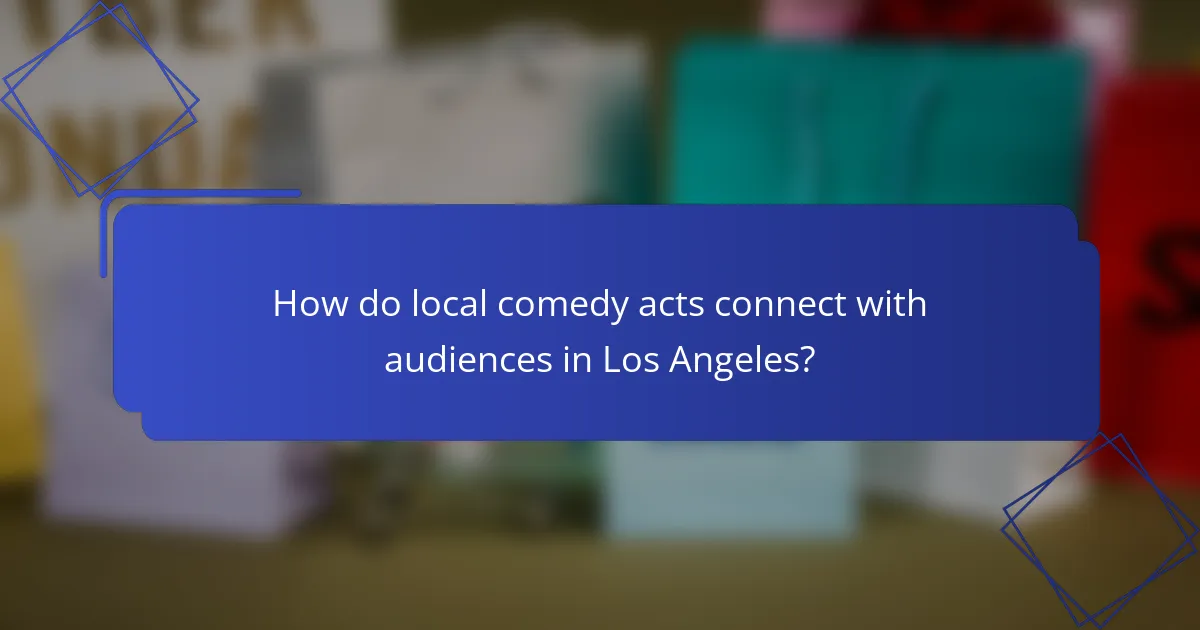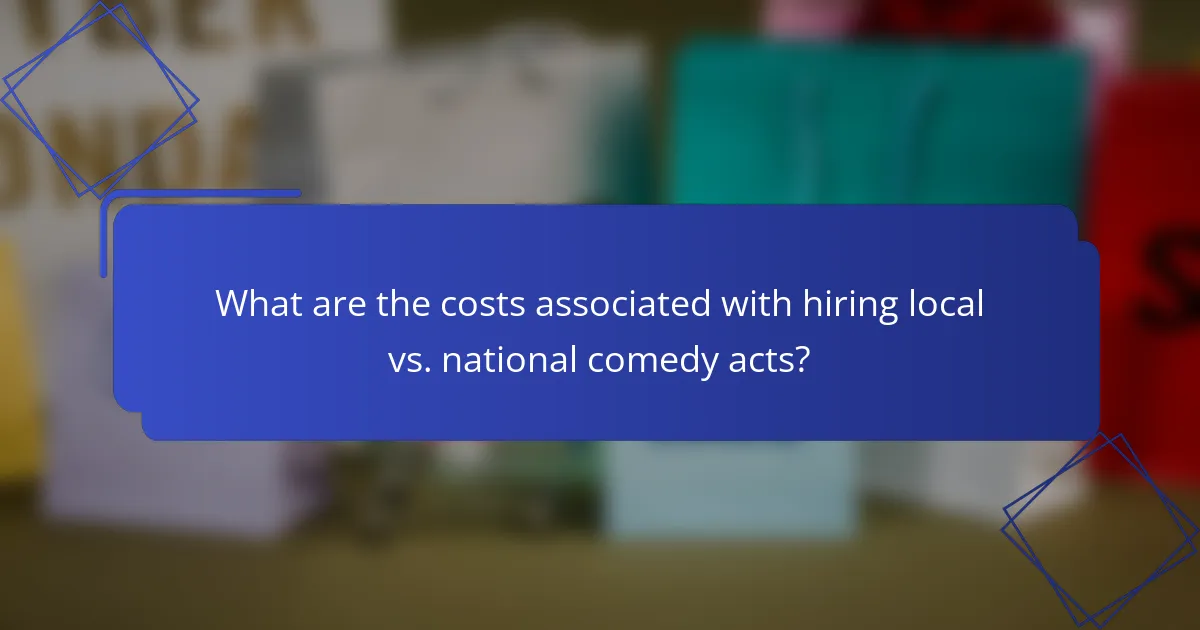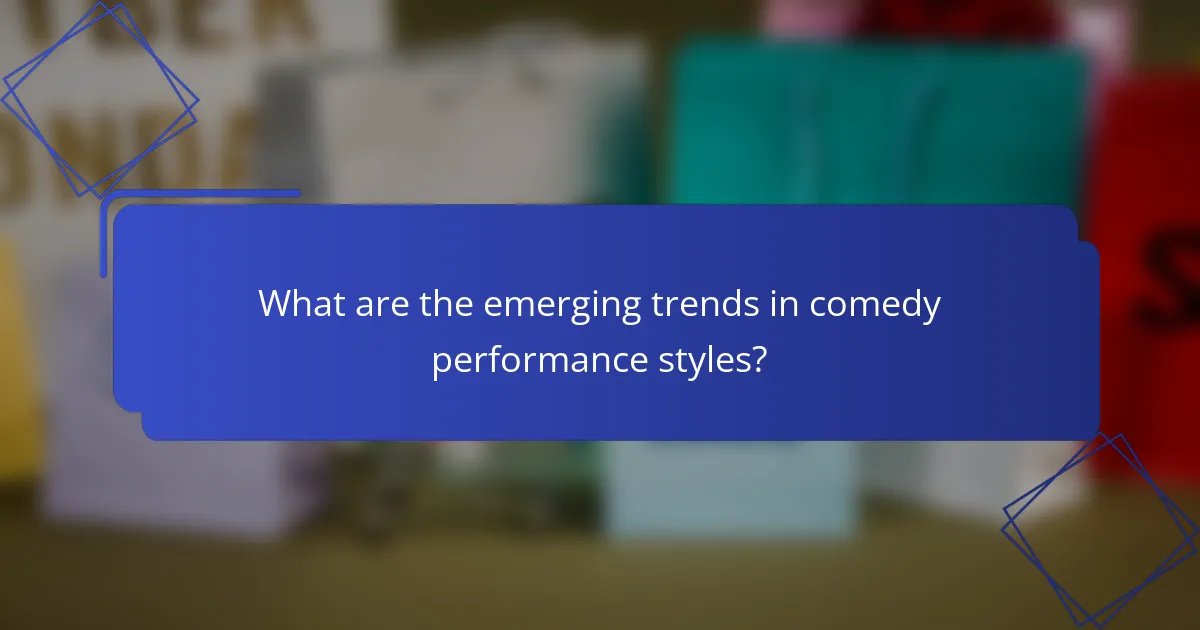When comparing local and national comedy acts, the connection with the audience plays a crucial role, as local performers often draw on relatable humor and community ties. Their performance styles also differ, with local acts focusing on intimate, culturally relevant themes, while national comedians tend to use broader, more polished approaches to engage larger audiences. Additionally, the cost of hiring these comedians varies significantly, with local acts generally being more budget-friendly than their nationally recognized counterparts.

How do local comedy acts connect with audiences in Los Angeles?
Local comedy acts in Los Angeles connect with audiences through relatable humor, community involvement, and references that resonate with the local culture. These elements create a unique bond between performers and their audience, enhancing the overall experience.
Personalized humor
Local comedians often tailor their material to reflect the experiences and values of their audience. This personalized humor allows them to address specific issues or quirks that resonate with Los Angeles residents, making the performance feel more intimate and relevant.
For instance, a comedian might joke about the traffic on the 405 or the latest trends in Hollywood, which instantly connects with locals who share those experiences. This approach fosters a sense of camaraderie and understanding between the performer and the audience.
Community engagement
Engaging with the community is a hallmark of local comedy acts. Many comedians participate in local events, collaborate with other artists, or support charitable causes, which helps to build a loyal following. This involvement not only enhances their visibility but also strengthens their ties to the audience.
For example, a comedian might host a charity show for a local nonprofit, inviting community members to participate. This creates a shared experience that goes beyond just entertainment, reinforcing the comedian’s connection to the audience.
Local references
Using local references is a powerful tool for comedians in Los Angeles. By incorporating familiar landmarks, cultural icons, or regional slang into their routines, they create a shared context that resonates with the audience. This strategy makes the humor more accessible and enjoyable.
Comedians might reference popular spots like Venice Beach or the Hollywood sign, evoking a sense of pride and recognition among locals. These references not only enhance the humor but also create a collective identity that strengthens the audience’s connection to the performance.

What performance styles differentiate local and national comedy acts?
Local and national comedy acts differ significantly in their performance styles, primarily due to audience size, venue type, and cultural context. Local acts often focus on relatable, community-based humor, while national acts may employ broader themes and polished techniques to appeal to diverse audiences.
Improvisation techniques
Local comedians frequently utilize improvisation techniques that resonate with their immediate audience. They may engage in spontaneous interactions, drawing humor from local events or familiar situations, which fosters a sense of connection. In contrast, national comedians often rely on scripted material with occasional improvisation, ensuring that their performance is cohesive and polished for larger venues.
For local acts, honing improvisation skills is crucial. They should practice quick thinking and adaptability to respond to audience reactions effectively. National acts, while still valuing improvisation, often balance it with rehearsed segments to maintain flow and timing.
Storytelling approaches
Storytelling is a vital aspect of both local and national comedy, but their approaches differ. Local comedians tend to share personal anecdotes that reflect their community’s experiences, making their stories relatable and engaging. National comedians, however, often craft broader narratives that can appeal to various demographics, sometimes incorporating universal themes or experiences.
Local acts should focus on authenticity in their storytelling, using humor to highlight unique cultural aspects. National acts benefit from refining their stories to ensure they resonate across different audiences, often testing material in various markets before finalizing their performances.
Audience interaction
Audience interaction is a hallmark of local comedy, where comedians frequently engage directly with attendees, creating a lively atmosphere. This interaction can include asking questions, responding to hecklers, or incorporating audience members into the act, which enhances the overall experience. National comedians may interact with the audience as well, but this is usually more structured and less spontaneous, given the larger crowd size.
Local comedians should embrace audience interaction to build rapport and create memorable moments. National acts, while still valuing engagement, should focus on maintaining control over the performance and ensuring that audience interactions align with their overall comedic narrative.

What are the costs associated with hiring local vs. national comedy acts?
The costs of hiring local versus national comedy acts can vary significantly based on their popularity, experience, and the scope of the event. Local comedians typically charge lower fees compared to national acts, which can demand higher rates due to their established reputation and broader appeal.
Average fees for local comedians
Local comedians generally charge between a few hundred to a couple of thousand dollars for their performances. The exact fee often depends on the comedian’s experience, the length of the set, and the type of event. For smaller venues or community events, you might find local talent willing to perform for as little as $200 to $500.
When booking local comedians, consider their audience connection and familiarity with local culture, which can enhance the overall experience. This can be especially beneficial for events looking for relatable humor that resonates with the local crowd.
Average fees for national comedians
National comedians typically command fees ranging from several thousand to tens of thousands of dollars. Well-known acts may charge upwards of $10,000, while emerging national talent might start around $5,000. These fees reflect their broader recognition and the demand for their performances across various markets.
When considering a national comedian, it’s essential to evaluate their appeal to your specific audience. While they may bring star power, ensure their style aligns with the event’s theme and the audience’s preferences.
Additional expenses for travel and accommodations
In addition to performance fees, hiring national comedians often incurs extra costs for travel and accommodations. Depending on the comedian’s location, travel expenses can include flights, ground transportation, and meals, which can add several hundred to thousands of dollars to the overall budget.
For local comedians, travel costs are typically minimal or non-existent, making them a more cost-effective option for events with tight budgets. However, if a local comedian is traveling from a distant city, be sure to clarify any additional expenses upfront to avoid surprises.

How does audience size affect comedy performance dynamics?
The size of the audience significantly influences the dynamics of a comedy performance. Smaller audiences tend to create a more intimate atmosphere, while larger crowds can amplify the energy but may dilute personal connections.
Intimacy in smaller venues
Performing in smaller venues, such as comedy clubs or intimate theaters, allows comedians to connect closely with their audience. This setting fosters a sense of shared experience, where laughter can be contagious and immediate feedback is more pronounced.
In these environments, comedians often adapt their material based on audience reactions, making the performance feel more personalized. The ability to engage directly with audience members can lead to spontaneous interactions, enhancing the overall experience.
Scalability in larger venues
Larger venues, such as arenas or festivals, present unique challenges and opportunities for comedians. While the audience size can create an electrifying atmosphere, it often requires a different performance style that relies on broader gestures and louder delivery to reach the back rows.
Comedians may need to adjust their material to resonate with a diverse audience, which can sometimes lead to a more generalized approach. However, successful acts often leverage the scale by incorporating visual elements or multimedia to maintain engagement across a larger crowd.

What are the prerequisites for booking a comedy act?
Booking a comedy act requires understanding the specific needs of your event, including the type of comedy, audience preferences, and budget constraints. Key prerequisites include selecting the right performer, ensuring availability, and negotiating fees.
Understanding audience demographics
Knowing your audience demographics is crucial when booking a comedy act. Factors such as age, cultural background, and interests can significantly influence the type of humor that resonates. For example, a younger audience may prefer contemporary, edgy comedy, while an older crowd might appreciate classic stand-up routines.
To effectively connect with your audience, consider conducting surveys or gathering feedback from previous events. This information can guide you in selecting a comedian whose style aligns with the preferences of your attendees, enhancing overall engagement and satisfaction.
Venue capacity considerations
Venue capacity plays a vital role in the success of a comedy act. A small, intimate setting may be ideal for personal storytelling and interactive performances, while larger venues can accommodate more mainstream acts that require a broader appeal. Ensure the venue can comfortably fit your expected audience size to maintain an enjoyable atmosphere.
When booking, consider the logistics of the venue, such as stage visibility and acoustics. A well-suited space enhances the performance experience, so evaluate options that align with the comedian’s style and your audience’s expectations. Aim for a venue that can hold at least 70-80% of your anticipated audience to create a lively environment without feeling empty.

How do local comedy acts adapt to cultural trends in New York?
Local comedy acts in New York adapt to cultural trends by closely observing the social dynamics and current events that resonate with their audience. They often tailor their material to reflect the unique experiences and issues faced by New Yorkers, making their performances relatable and timely.
Topical humor relevance
Topical humor is crucial for local comedians as it allows them to connect with audiences on shared experiences. For instance, jokes about recent political events, local sports teams, or neighborhood happenings can elicit stronger reactions than generic material. Comedians often stay informed about trending topics through social media and local news to ensure their content remains relevant.
In New York, where cultural diversity is significant, comedians may also incorporate elements from various communities, enhancing their appeal. This approach not only entertains but also fosters a sense of community among audience members who share similar backgrounds or experiences.
Audience feedback incorporation
Local comedians frequently adjust their performances based on audience feedback, which can be immediate and impactful. They may gauge reactions during shows to determine which jokes land well and which do not, allowing for real-time modifications. This adaptability helps them refine their acts and improve audience engagement.
Comedians often solicit feedback through social media or post-show discussions, providing insights into what resonates with their audience. By actively listening to their fans, they can develop more tailored content that reflects the evolving tastes and preferences of New Yorkers, ensuring continued relevance in a dynamic cultural landscape.

What are the emerging trends in comedy performance styles?
Emerging trends in comedy performance styles reflect shifts in audience preferences and technological advancements. Comedians are increasingly blending traditional stand-up with digital platforms, interactive elements, and diverse storytelling techniques to engage audiences more effectively.
Audience Connection
Building a strong connection with the audience is crucial for comedians today. Performers are using social media to gauge audience reactions and tailor their material accordingly. This real-time feedback allows comedians to adjust their performances based on the crowd’s energy and preferences.
Moreover, many comedians are incorporating personal stories and relatable experiences to foster intimacy with their audience. This approach not only enhances engagement but also creates a shared experience that resonates on a deeper level.
Performance Style
Contemporary comedy often features a mix of improvisation and scripted material. Comedians are experimenting with formats that include audience participation, making each show unique. This unpredictability can lead to memorable moments that enhance the overall experience.
Additionally, the rise of online platforms has encouraged comedians to adopt shorter, punchier formats. This shift caters to audiences with shorter attention spans, as seen in viral videos and social media clips that deliver quick laughs.
Cost Considerations
The cost of attending comedy shows varies widely based on the performer’s stature and venue. Local acts typically offer lower ticket prices, making them accessible to a broader audience. In contrast, national acts often command higher fees, reflecting their established reputation and larger production costs.
When budgeting for a comedy night, consider not only ticket prices but also additional expenses such as food, drinks, and transportation. Local venues may provide more affordable options, while larger theaters might include premium seating that raises overall costs.



